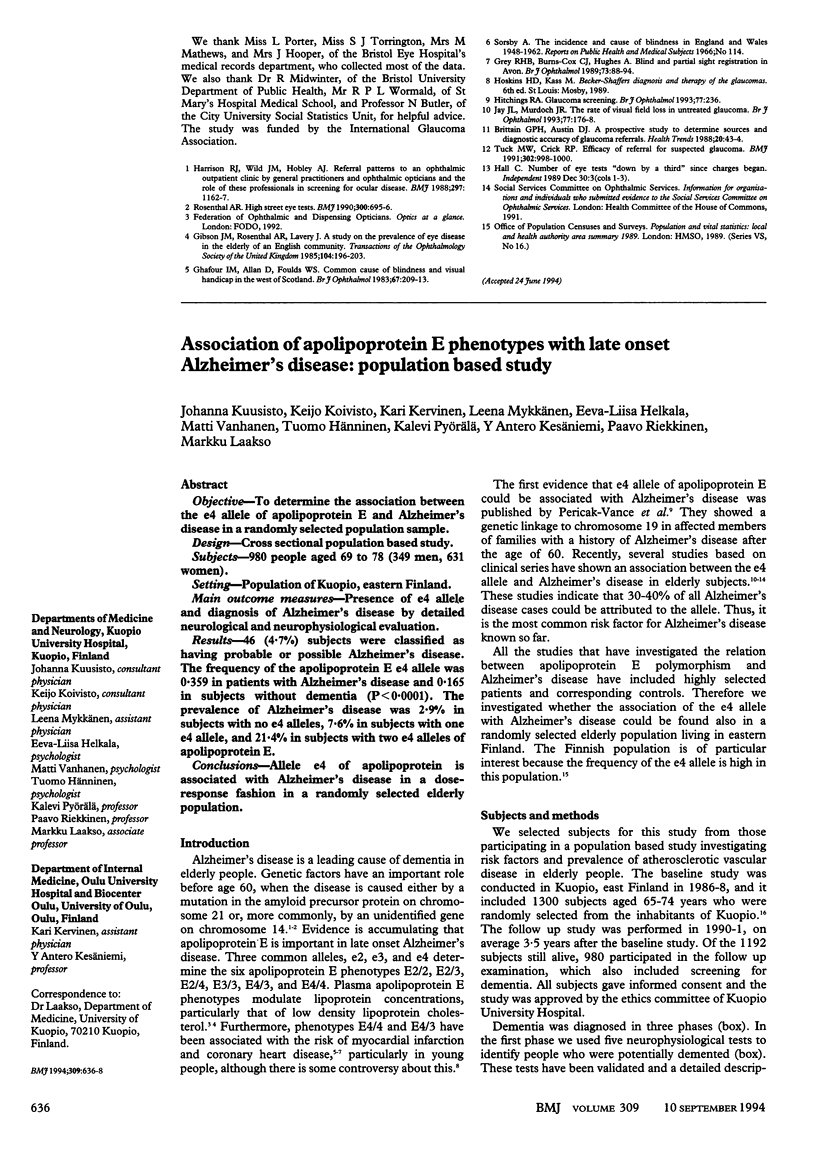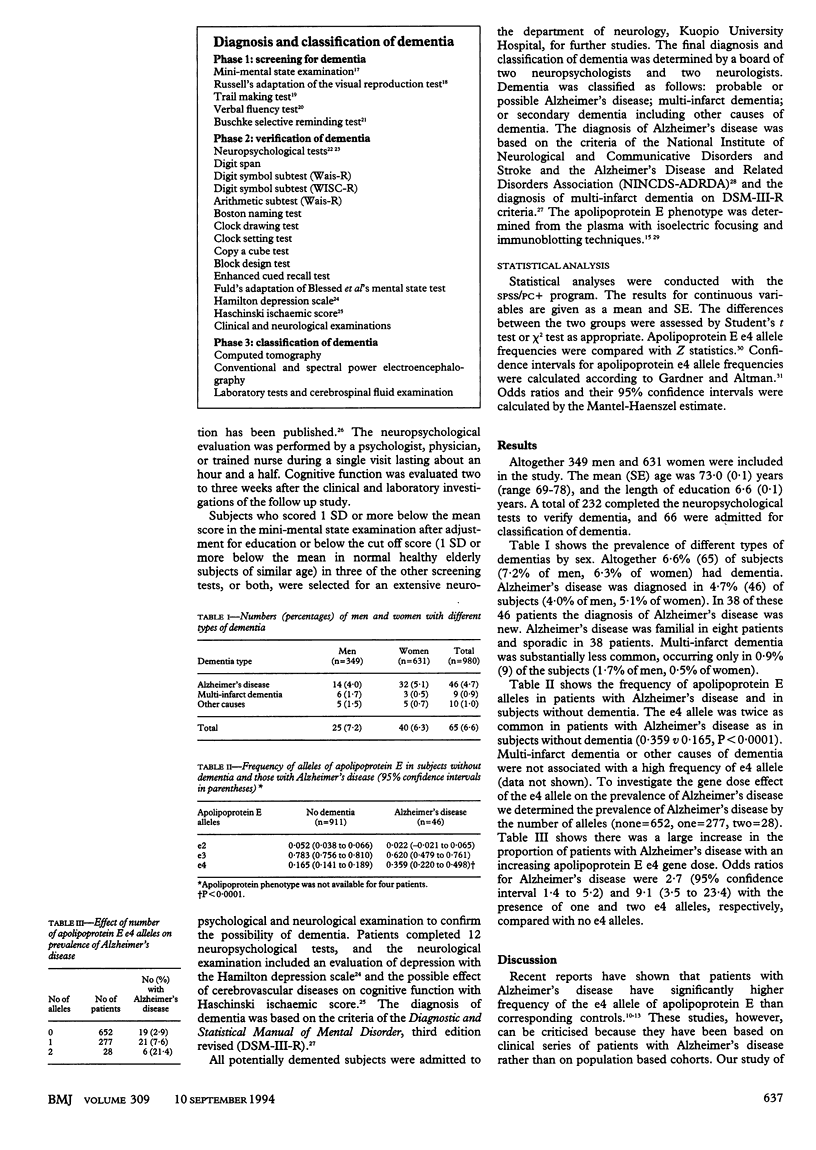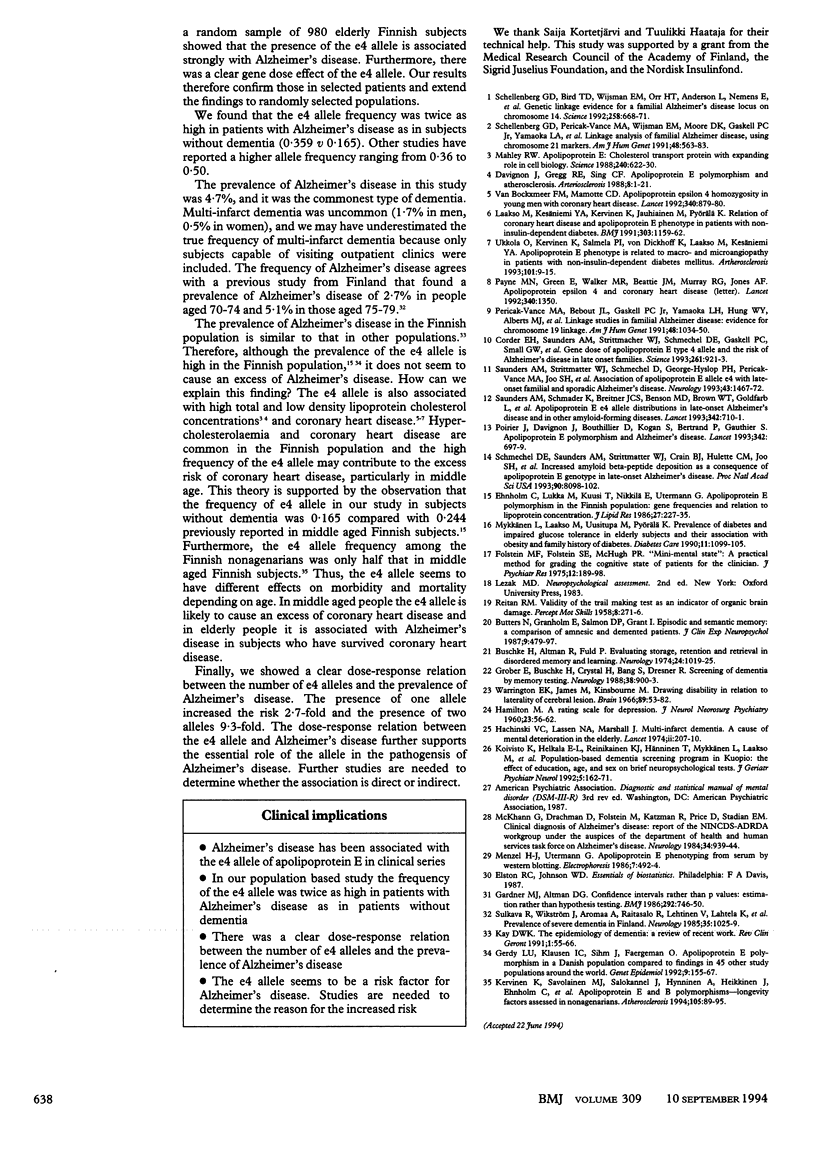Abstract
OBJECTIVE--To determine the association between the e4 allele of apolipoprotein E and Alzheimer's disease in a randomly selected population sample. DESIGN--Cross sectional population based study. SUBJECTS--980 people aged 69 to 78 (349 men, 631 women). SETTING--Population of Kuopio, eastern Finland. MAIN OUTCOME MEASURES--Presence of e4 allele and diagnosis of Alzheimer's disease by detailed neurological and neurophysiological evaluation. RESULTS--46 (4.7%) subjects were classified as having probable or possible Alzheimer's disease. The frequency of the apolipoprotein E e4 allele was 0.359 in patients with Alzheimer's disease and 0.165 subjects without dementia (P < 0.0001). The prevalence of Alzheimer's disease was 2.9% in subjects with no e4 alleles, 7.6% in subjects with one e4 allele, and 21.4% in subjects with two e4 alleles of apolipoprotein E. CONCLUSIONS--Allele e4 of apolipoprotein is associated with Alzheimer's disease in a dose-response fashion in a randomly selected elderly population.
Full text
PDF


Selected References
These references are in PubMed. This may not be the complete list of references from this article.
- Buschke H., Fuld P. A. Evaluating storage, retention, and retrieval in disordered memory and learning. Neurology. 1974 Nov;24(11):1019–1025. doi: 10.1212/wnl.24.11.1019. [DOI] [PubMed] [Google Scholar]
- Butters N., Granholm E., Salmon D. P., Grant I., Wolfe J. Episodic and semantic memory: a comparison of amnesic and demented patients. J Clin Exp Neuropsychol. 1987 Oct;9(5):479–497. doi: 10.1080/01688638708410764. [DOI] [PubMed] [Google Scholar]
- Corder E. H., Saunders A. M., Strittmatter W. J., Schmechel D. E., Gaskell P. C., Small G. W., Roses A. D., Haines J. L., Pericak-Vance M. A. Gene dose of apolipoprotein E type 4 allele and the risk of Alzheimer's disease in late onset families. Science. 1993 Aug 13;261(5123):921–923. doi: 10.1126/science.8346443. [DOI] [PubMed] [Google Scholar]
- Davignon J., Gregg R. E., Sing C. F. Apolipoprotein E polymorphism and atherosclerosis. Arteriosclerosis. 1988 Jan-Feb;8(1):1–21. doi: 10.1161/01.atv.8.1.1. [DOI] [PubMed] [Google Scholar]
- Ehnholm C., Lukka M., Kuusi T., Nikkilä E., Utermann G. Apolipoprotein E polymorphism in the Finnish population: gene frequencies and relation to lipoprotein concentrations. J Lipid Res. 1986 Mar;27(3):227–235. [PubMed] [Google Scholar]
- Folstein M. F., Folstein S. E., McHugh P. R. "Mini-mental state". A practical method for grading the cognitive state of patients for the clinician. J Psychiatr Res. 1975 Nov;12(3):189–198. doi: 10.1016/0022-3956(75)90026-6. [DOI] [PubMed] [Google Scholar]
- Gardner M. J., Altman D. G. Confidence intervals rather than P values: estimation rather than hypothesis testing. Br Med J (Clin Res Ed) 1986 Mar 15;292(6522):746–750. doi: 10.1136/bmj.292.6522.746. [DOI] [PMC free article] [PubMed] [Google Scholar]
- Gerdes L. U., Klausen I. C., Sihm I., Faergeman O. Apolipoprotein E polymorphism in a Danish population compared to findings in 45 other study populations around the world. Genet Epidemiol. 1992;9(3):155–167. doi: 10.1002/gepi.1370090302. [DOI] [PubMed] [Google Scholar]
- Grober E., Buschke H., Crystal H., Bang S., Dresner R. Screening for dementia by memory testing. Neurology. 1988 Jun;38(6):900–903. doi: 10.1212/wnl.38.6.900. [DOI] [PubMed] [Google Scholar]
- HAMILTON M. A rating scale for depression. J Neurol Neurosurg Psychiatry. 1960 Feb;23:56–62. doi: 10.1136/jnnp.23.1.56. [DOI] [PMC free article] [PubMed] [Google Scholar]
- Hachinski V. C., Lassen N. A., Marshall J. Multi-infarct dementia. A cause of mental deterioration in the elderly. Lancet. 1974 Jul 27;2(7874):207–210. doi: 10.1016/s0140-6736(74)91496-2. [DOI] [PubMed] [Google Scholar]
- Kervinen K., Savolainen M. J., Salokannel J., Hynninen A., Heikkinen J., Ehnholm C., Koistinen M. J., Kesäniemi Y. A. Apolipoprotein E and B polymorphisms--longevity factors assessed in nonagenarians. Atherosclerosis. 1994 Jan;105(1):89–95. doi: 10.1016/0021-9150(94)90011-6. [DOI] [PubMed] [Google Scholar]
- Koivisto K., Helkala E. L., Reinikainen K. J., Hänninen T., Mykkänen L., Laakso M., Pyörälä K., Riekkinen P. J. Population-based dementia screening program in Kuopio: the effect of education, age, and sex on brief neuropsychological tests. J Geriatr Psychiatry Neurol. 1992 Jul-Sep;5(3):162–171. doi: 10.1177/002383099200500306. [DOI] [PubMed] [Google Scholar]
- Laakso M., Kesäniemi A., Kervinen K., Jauhiainen M., Pyörälä K. Relation of coronary heart disease and apolipoprotein E phenotype in patients with non-insulin dependent diabetes. BMJ. 1991 Nov 9;303(6811):1159–1162. doi: 10.1136/bmj.303.6811.1159. [DOI] [PMC free article] [PubMed] [Google Scholar]
- Mahley R. W. Apolipoprotein E: cholesterol transport protein with expanding role in cell biology. Science. 1988 Apr 29;240(4852):622–630. doi: 10.1126/science.3283935. [DOI] [PubMed] [Google Scholar]
- McKhann G., Drachman D., Folstein M., Katzman R., Price D., Stadlan E. M. Clinical diagnosis of Alzheimer's disease: report of the NINCDS-ADRDA Work Group under the auspices of Department of Health and Human Services Task Force on Alzheimer's Disease. Neurology. 1984 Jul;34(7):939–944. doi: 10.1212/wnl.34.7.939. [DOI] [PubMed] [Google Scholar]
- Mykkänen L., Laakso M., Uusitupa M., Pyörälä K. Prevalence of diabetes and impaired glucose tolerance in elderly subjects and their association with obesity and family history of diabetes. Diabetes Care. 1990 Nov;13(11):1099–1105. doi: 10.2337/diacare.13.11.1099. [DOI] [PubMed] [Google Scholar]
- Payne M. N., Green E., Walker M. R., Beattie J. M., Murray R. G., Jones A. F. Apolipoprotein epsilon 4 and coronary artery disease. Lancet. 1992 Nov 28;340(8831):1350–1350. [PubMed] [Google Scholar]
- Pericak-Vance M. A., Bebout J. L., Gaskell P. C., Jr, Yamaoka L. H., Hung W. Y., Alberts M. J., Walker A. P., Bartlett R. J., Haynes C. A., Welsh K. A. Linkage studies in familial Alzheimer disease: evidence for chromosome 19 linkage. Am J Hum Genet. 1991 Jun;48(6):1034–1050. [PMC free article] [PubMed] [Google Scholar]
- Poirier J., Davignon J., Bouthillier D., Kogan S., Bertrand P., Gauthier S. Apolipoprotein E polymorphism and Alzheimer's disease. Lancet. 1993 Sep 18;342(8873):697–699. doi: 10.1016/0140-6736(93)91705-q. [DOI] [PubMed] [Google Scholar]
- Saunders A. M., Schmader K., Breitner J. C., Benson M. D., Brown W. T., Goldfarb L., Goldgaber D., Manwaring M. G., Szymanski M. H., McCown N. Apolipoprotein E epsilon 4 allele distributions in late-onset Alzheimer's disease and in other amyloid-forming diseases. Lancet. 1993 Sep 18;342(8873):710–711. doi: 10.1016/0140-6736(93)91709-u. [DOI] [PubMed] [Google Scholar]
- Saunders A. M., Strittmatter W. J., Schmechel D., George-Hyslop P. H., Pericak-Vance M. A., Joo S. H., Rosi B. L., Gusella J. F., Crapper-MacLachlan D. R., Alberts M. J. Association of apolipoprotein E allele epsilon 4 with late-onset familial and sporadic Alzheimer's disease. Neurology. 1993 Aug;43(8):1467–1472. doi: 10.1212/wnl.43.8.1467. [DOI] [PubMed] [Google Scholar]
- Schellenberg G. D., Bird T. D., Wijsman E. M., Orr H. T., Anderson L., Nemens E., White J. A., Bonnycastle L., Weber J. L., Alonso M. E. Genetic linkage evidence for a familial Alzheimer's disease locus on chromosome 14. Science. 1992 Oct 23;258(5082):668–671. doi: 10.1126/science.1411576. [DOI] [PubMed] [Google Scholar]
- Schellenberg G. D., Pericak-Vance M. A., Wijsman E. M., Moore D. K., Gaskell P. C., Jr, Yamaoka L. A., Bebout J. L., Anderson L., Welsh K. A., Clark C. M. Linkage analysis of familial Alzheimer disease, using chromosome 21 markers. Am J Hum Genet. 1991 Mar;48(3):563–583. [PMC free article] [PubMed] [Google Scholar]
- Strittmatter W. J., Weisgraber K. H., Huang D. Y., Dong L. M., Salvesen G. S., Pericak-Vance M., Schmechel D., Saunders A. M., Goldgaber D., Roses A. D. Binding of human apolipoprotein E to synthetic amyloid beta peptide: isoform-specific effects and implications for late-onset Alzheimer disease. Proc Natl Acad Sci U S A. 1993 Sep 1;90(17):8098–8102. doi: 10.1073/pnas.90.17.8098. [DOI] [PMC free article] [PubMed] [Google Scholar]
- Sulkava R., Wikström J., Aromaa A., Raitasalo R., Lehtinen V., Lahtela K., Palo J. Prevalence of severe dementia in Finland. Neurology. 1985 Jul;35(7):1025–1029. doi: 10.1212/wnl.35.7.1025. [DOI] [PubMed] [Google Scholar]
- Ukkola O., Kervinen K., Salmela P. I., von Dickhoff K., Laakso M., Kesäniemi Y. A. Apolipoprotein E phenotype is related to macro- and microangiopathy in patients with non-insulin-dependent diabetes mellitus. Atherosclerosis. 1993 Jun;101(1):9–15. doi: 10.1016/0021-9150(93)90096-d. [DOI] [PubMed] [Google Scholar]
- Warrington E. K., James M., Kinsbourne M. Drawing disability in relation to laterality of cerebral lesion. Brain. 1966 Mar;89(1):53–82. doi: 10.1093/brain/89.1.53. [DOI] [PubMed] [Google Scholar]
- van Bockxmeer F. M., Mamotte C. D. Apolipoprotein epsilon 4 homozygosity in young men with coronary heart disease. Lancet. 1992 Oct 10;340(8824):879–880. doi: 10.1016/0140-6736(92)93288-x. [DOI] [PubMed] [Google Scholar]


